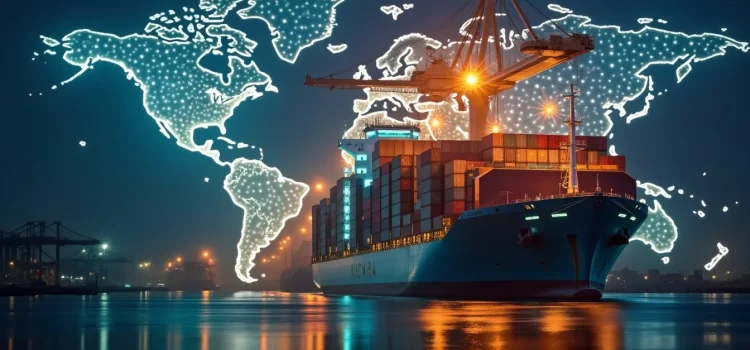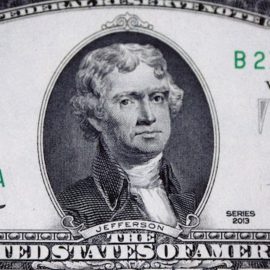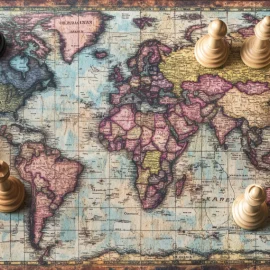

This article is an excerpt from the Shortform book guide to "The End of the World Is Just the Beginning" by Peter Zeihan. Shortform has the world's best summaries and analyses of books you should be reading.
Like this article? Sign up for a free trial here.
How did the world become so interconnected? What factors led to the era of globalization after WWII?
Peter Zeihan’s book The End of the World Is Just the Beginning explores the rise of global trade and its impact on our modern world. He delves into the historical, geographical, and technological factors that shaped international commerce following the Second World War.
Keep reading to discover how the United States reshaped the world order and ushered in an unprecedented era of economic growth and stability.
Globalization After WWII
In his book, Zeihan discusses the age of globalization after WWII. He defines globalization as the system of free and safe trade between countries, characterized by international economic competition and interdependence on a worldwide scale. Zeihan contrasts this to the prior status quo of empire-building and wars over resources, which climaxed in the first half of the 20th century before the United States changed the paradigm of international commerce.
(Shortform note: Zeihan defines globalization purely in terms of international trade, but that’s not the only way to frame it. According to the World Health Organization, globalization also refers to how governments, businesses, and organizations adapt to the realities of international interdependence. The term is also used to describe the free flow of capital, technology, and intellectual property across international boundaries.)
Throughout history, geography has played a crucial role in determining a country’s survival and stability. This is why the first civilizations emerged in river valleys that were favorable for agriculture, had reliable water sources, and possessed natural defenses against invaders. As technology advanced, we harnessed new energy sources, starting with wind before moving on to coal and then oil. Zeihan explains that the countries that possessed such technological advantages could move their militaries more effectively than their rivals. They conquered their neighbors to acquire more resources, building empires as they did so.
| The Importance of Lines on a Map Zeihan describes the boundaries of nations as if they’re only determined by geography, which may have been true in ancient times, but is no longer the case today. In Prisoners of Geography, Tim Marshall explains that human geography—the distribution of competing religious and ethnic groups—can be as important to international trade and conflict as the distribution of natural resources. Marshall also observes that when countries’ borders are drawn with no thought to ethnic or geographic concerns—such as when Europeans subdivided Africa—the result is greater internal strife within the new nations’ arbitrary boundaries. Zeihan also discusses technology as a means for countries to overcome geographic limitations, but Marshall points out that technology can be used to change geography itself. Sometimes this is deliberate, such as when we carved through barriers to shipping by building the Suez and Panama canals. Sometimes, however, changes are unintended, as in the case of global warming. Rising temperatures have opened new trade routes north of Russia and Canada by causing polar ice to recede, but coastal economic centers worldwide are in increased danger of flooding as sea levels rise and coastlines shrink. |
The End of the Old World
Technological progress also increased humanity’s capacity for destruction, culminating in the two World Wars that devastated much of the industrialized world. The US, with its geographic protections and abundant natural resources, emerged from World War II as the only remaining country with a robust economy, a functioning industrial sector, and a strong military. Zeihan says that, instead of asserting itself as an empire, the US used its advantage to create a new world order—one aimed at isolating and economically strangling the Soviet Union. The US offered the world a deal: Align against the Soviet Union, and in return, the US would become the world’s police to ensure that international trade could flourish—except in the Soviet bloc.
(Shortform note: Though the alliance Zeihan describes is often remembered as a struggle between communism and capitalism, the US government was willing to cooperate with communist nations so long as they were aligned against the Soviet Union. Specifically, the US maintained economic and diplomatic ties with communist governments in Yugoslavia, Somalia, and China at various points during the Cold War. This suggests the conflict was less about opposing communism and more about opposing the Soviets and their allies.)
Zeihan asserts that, during this period, we’ve lived in an era of unprecedented economic growth and stability facilitated by the US’s commitment to protecting worldwide trade and transportation. As a result, many previously undeveloped countries were able to industrialize rapidly and join the global market. These formerly agrarian nations now house a growing number of their people in cities, where power, water, and food must be sourced from elsewhere. To date, that’s been comparatively easy, since for over 70 years, the US Navy has safeguarded global shipping.
(Shortform note: In A People’s History of the United States, Howard Zinn recounts that there was more to the US’s post-World War II strategy than merely fostering trade. By funding reconstruction programs in Western Europe, the US gained significant control over the newly formed United Nations and International Monetary Fund. Because of its uncontested economic strength, enough money flowed into the country to provide benefits to many American workers and laborers, helping them buy homes, attend college, and raise their overall standards of living. At the same time, however, Zinn suggests that military, business, and political elites made sure the existing war economy would continue indefinitely under the US’s guise as global protector.)
International Trade
Zeihan argues that the importance of the US’s commitment to protecting international shipping can’t be overstated. Safe, cheap, and reliable shipping underpins every aspect of globalization, from importing and exporting finished products, to playing a vital role in global supply chains, access to energy, and our ability to feed the Earth’s booming population.
Even before globalization, advances such as deep-water sailing and rail travel changed the limits set on countries by geography. Sailing opened the oceans for international trade, while rail provided easy access to countries’ interiors, letting them ship farm products abroad with relative ease. However, Zeihan writes that, prior to globalization, empires generally didn’t trade with each other—trade flowed between a ruling country and its conquered vassal states while competing empires preyed on each other through the use of state-sponsored piracy. However, when the US changed this paradigm at the end of World War II by agreeing to keep the oceans safe for travel, it effectively rendered the “imperial” model of international trade defunct.
(Shortform note: Critics of Zeihan’s perspective argue that the idea that global trade depends on a constant US naval presence is exaggerated. Most shipping lanes face little threat beyond natural hazards in peacetime, and while piracy is occasionally an issue in a handful of places around the world, it only affects a tiny fraction of global trade. In the majority of maritime settings, the US Navy’s role is more focused on deterrence than policing trade routes, and diplomacy rather than military action is the norm for addressing disputes in international waters.)
As a result, international trade boomed, with sea ports growing to accommodate the massive volume of cargo they had to handle. Since they didn’t have to defend themselves, ocean-going ships became large and slow, while transportation costs became almost negligible. Safe shipping allowed economies to flourish wherever people could produce and export goods, leading to rapid industrialization and dramatically higher standards of living. Zeihan says an unintended consequence of this system was that different countries could now specialize in producing whatever goods they excelled at, regardless of whether those products met their own citizens’ needs. Instead, they could simply import what they needed and export for profits.
(Shortform note: The importance of access to maritime shipping can be seen in the economic differences between landlocked countries and their neighbors with ports. For example, without direct access to the sea, Bolivia faces higher trade costs and reduced economic opportunities than its coastal neighbor Chile. Bolivia pays more for each container shipped, largely due to higher cost of transporting goods overland. Its geographic disadvantage has stunted Bolivia’s economic growth, with estimates suggesting its economy would be 20% larger if it had sea access. In contrast, Chile’s economy is six times larger than Bolivia’s, with maritime trade making up more than half of the country’s Gross Domestic Product.)
Manufacturing
Zeihan writes that modern shipping has made it possible for countries to specialize not only in producing specific types of products, but also in making specific parts of products, rather than the entire product itself. In this way, globalization has led to a worldwide manufacturing chain where each country serves as a link in the process. Meanwhile, businesses also outsource product design, sales, and distribution to even more countries, locating each task in the part of the world where it can be accomplished at the lowest cost.
(Shortform note: Despite the cost benefits that Zeihan presents, global supply chains have a significant environmental impact that far outweighs that of the manufacturing stage alone. For many products, transportation accounts for three times the amount of carbon emissions as the rest of the manufacturing process combined. However, the complexity and scale of supply chains make it hard for businesses to establish a full accounting of their own supply networks, or to exert sustainability controls over every step of the process.)
While globalized manufacturing makes products and services cheaper for businesses and consumers, this system is inherently brittle. Zeihan points out that long supply chains are extremely vulnerable to natural disasters, political turmoil, and war. If any part of the chain is interfered with, then everyone suffers the impact—suppliers of raw materials can’t reach their markets, those in the middle don’t have products to assemble, and consumers can’t buy the products they need.
(Shortform note: Depending on the bottleneck, supply chains are vulnerable to much smaller disruptions than the ones Zeihan lists. For instance, many global supply chains were put on hold in March 2021 by the accidental grounding of the container ship Ever Given, completely blocking the Suez Canal. The stoppage created a backlog of over 400 ships waiting to pass through the canal, impeding the flow of goods between Europe and Asia, and halting almost $10 billion worth of trade per day. The Suez Canal blockage was particularly impactful because it occurred during the Covid pandemic, when global supply chains were already strained.)
Protecting the Oil
Oil is the fuel that runs globalization, and without it, the system won’t function. However, oil is only found in certain locations and must be transported like any other commodity. Before World War II, every country guarded its private oil supply, but afterward, the US opened up the oil trade as part of its efforts to isolate the Soviet Union. Zeihan writes that any non-communist country with oil could enter the business and expect the US to protect its exports. The US’s own dependence on foreign oil gave it further motivation to keep oil traffic flowing, as seen in the first Gulf War. It wasn’t until the advent of “fracking”—drilling for hard-to-reach shale oil—that the US became oil-independent once again, reducing its need to fight for foreign oil.
(Shortform note: “Shale oil” is extracted by using water or explosives to fracture thinly layered shale rock formations, while conventional crude oil is typically drilled from more permeable sandstone or limestone reservoirs. In Blowout, Rachel Maddow recounts that the US developed fracking technology to access its shale oil and gas reserves so that it could take military action without fear of embargoes from oil-producing nations like Saudi Arabia. However, though the US is no longer dependent on Middle Eastern oil, Maddow states that its European allies have now become reliant on Russian natural gas, in a way upending the strategy Zeihan says the US put in place to hamstring Russia’s prior Soviet regime.)
Feeding the World
Hand-in-hand with advances in trade, globalization has revolutionized agriculture and worldwide food distribution. Industrial farming has increased the productivity of fertile land, which when combined with reliable transportation and refrigeration, has enabled places that previously couldn’t support large populations to do so. It has also allowed cities to expand, as they no longer need to be adjacent to their food supply. Zeihan says that as a result, while hunger still exists, it’s far less prevalent than it would be without globalization.
(Shortform note: Despite Zeihan’s point that famine would be more widespread without globalization, the number of people without access to food is growing worldwide. The chief reasons are military conflicts, economic crises, and changing weather patterns. These problems also hinder humanitarian missions from providing relief in times of food shortage. In particular, the war in Ukraine, a major food exporter, has heightened food distribution problems in many other countries. Combined with events such as droughts, floods, and storms, geopolitical factors often reinforce each other, creating complex food supply issues that affect millions of people worldwide, despite the low cost of international shipping.)
Global shipping has also let us reorganize where food is grown. Instead of using farms to feed their local communities, most agricultural locations now produce crops that make the most profit and ship them to wherever the demand for them is highest. We now have increasingly specialized agriculture, where countries no longer grow the food they need, but instead grow the food they can sell, expecting that they can import their own food from other farms thousands of miles away. Zeihan warns that while this system provides the world with a level of food diversity never seen before, it relies heavily on safe, reliable shipping. If the shipping network falls apart, so does the distribution of food.
(Shortform note: While cash crops are a boon for local economies, growing food for export rather than local consumption can have significant environmental impacts, from increased carbon emissions due to long-distance transportation, to the potential depletion of local water resources and soil erosion from intensive farming practices. However, the impact of cash crops isn’t always negative. In Indonesia, cash crops such as coffee, cocoa, and palm oil not only bolster the economy as exports, but also help to prevent soil erosion because of their ability to survive floods and droughts.)

———End of Preview———
Like what you just read? Read the rest of the world's best book summary and analysis of Peter Zeihan's "The End of the World Is Just the Beginning" at Shortform.
Here's what you'll find in our full The End of the World Is Just the Beginning summary:
- Why the golden age of international trade is about to end
- Why the collapse of international trade is the biggest threat to civilization
- How to prepare for tumultuous decades to come






